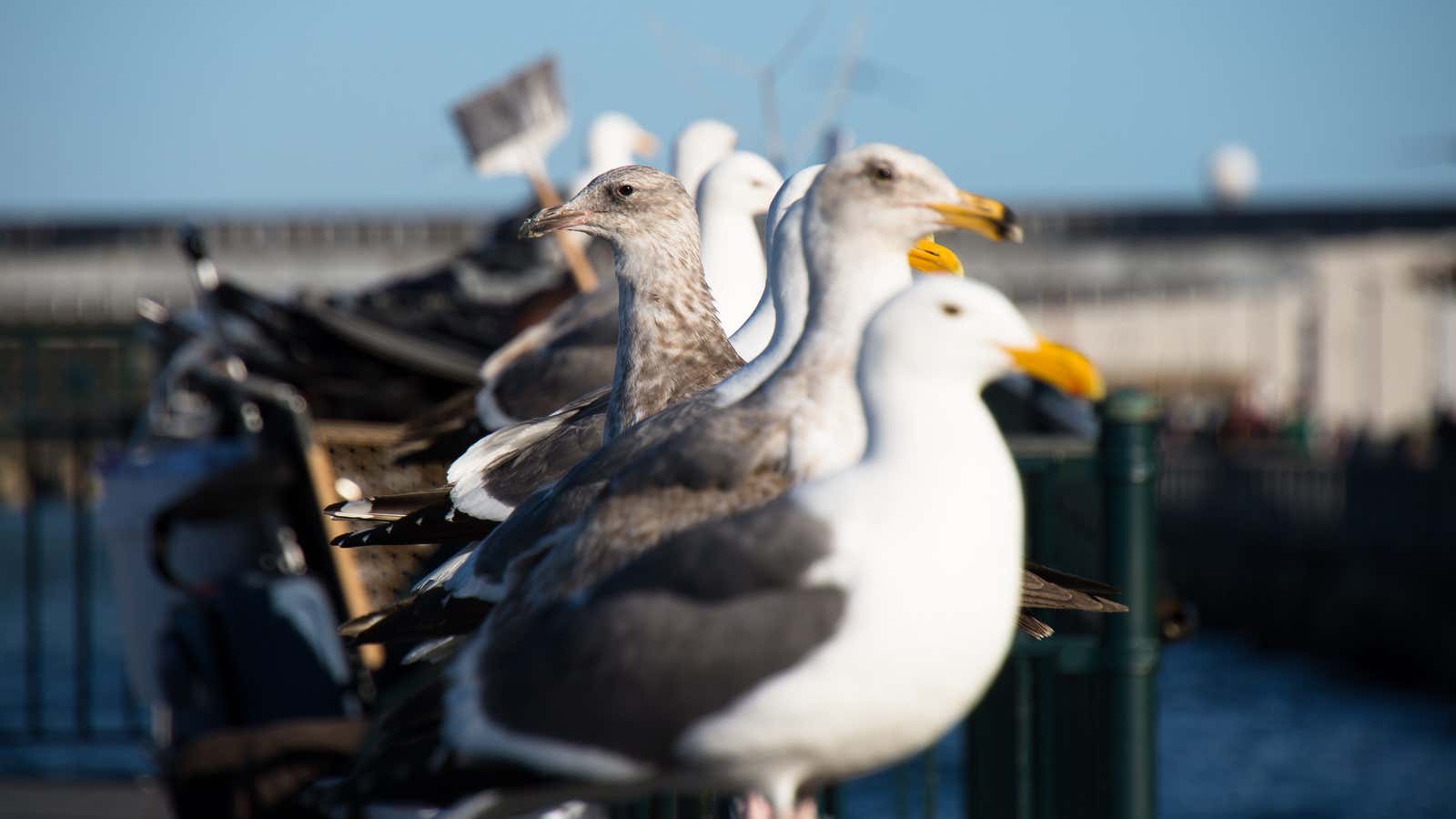The year was 1972, and George and Molly Hunt, a pair of married scientists, were headed out to a small island off of Santa Barbara, California, to initiate what would be a few months of research on the behavior of seagulls living there. George couldn’t stay long. He was teaching a class at the University of California-Irvine that spring semester, and had to return to Orange County; he would come back to the island every 10 days or so. But Molly stayed, camping out with a small group of students from the university, who did field work every day.
Early in the semester, Molly called George. She’d found a pair of female seagulls nesting together. They were even raising young together, just like any other seagull couple.
Female-female pairs? George didn’t believe her. “I poo-pooed it at first,” he says today. “I asked her, are you sure these were both on the same nest?” Molly insisted. “She was duly outraged that I questioned the care with which she did her science,” George remembers. Molly, it would turned out, was right. There were lesbian seagulls in California.
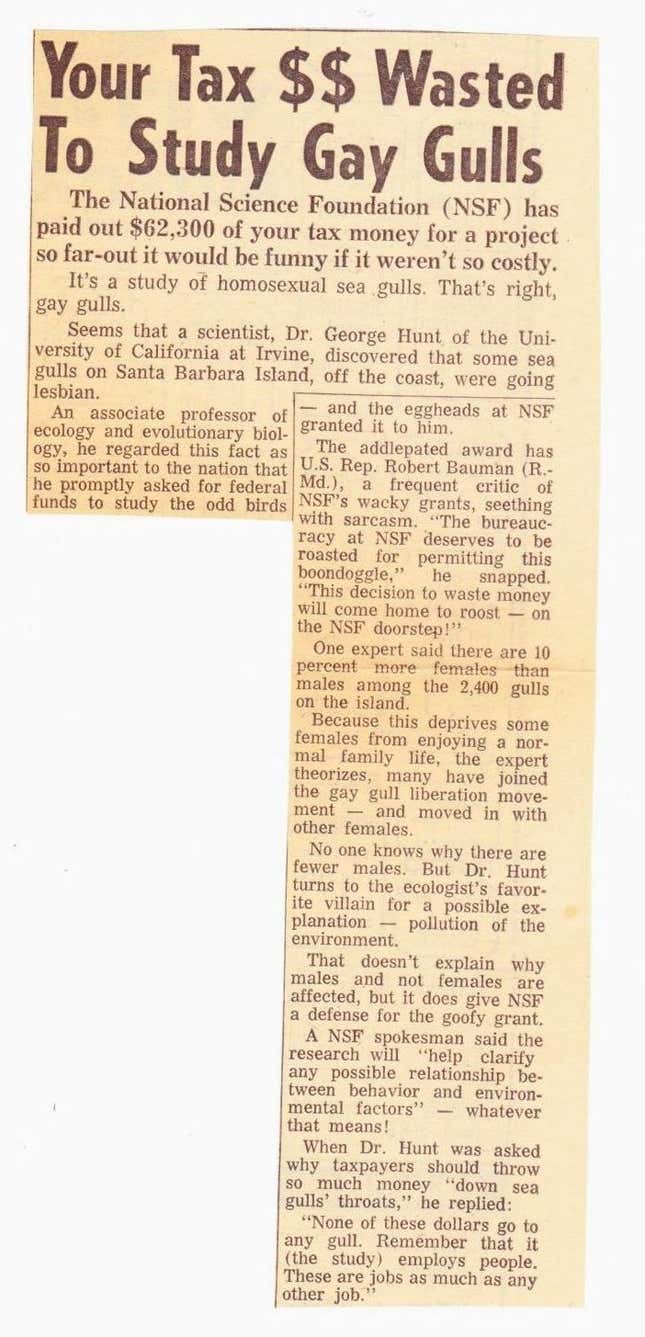
The discovery, published in 1977, triggered a controversy that shook the core of conservative Christianity and right wing of US politics. “At the time it was, I believe, the first published work on homosexuality in any wild animal,” George says. “The extreme right was very distressed.”
Their prevailing argument against homosexuality was that it wasn’t found in nature—God’s creation—and was therefore unnatural, and against God’s will. The presence of happily coupled female gulls poked a pretty big hole in that logic. “When people have their fundamental arguments compromised, they aren’t happy about it,” George says.
Complaints came in from all over the country. One group out of New York (the LA Times called it an “unscientific citizens task force”) published a statement proclaiming that “100% of the sea gulls in the five boroughs of New York City were heterosexual.” A business owner in Orange County, California took out a newspaper ad condemning the study:
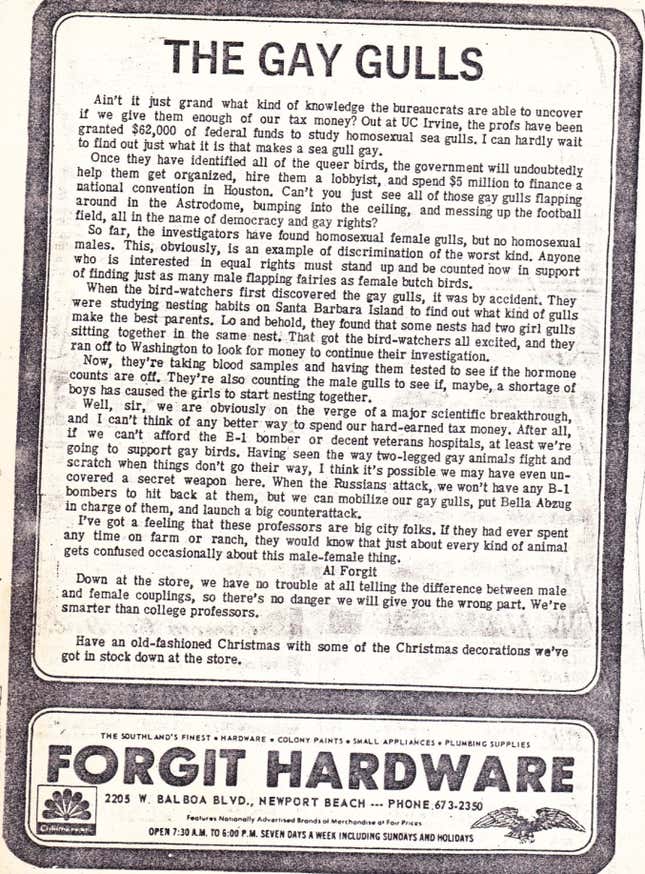
The gulls became a momentary staple in local newspaper cartoons:
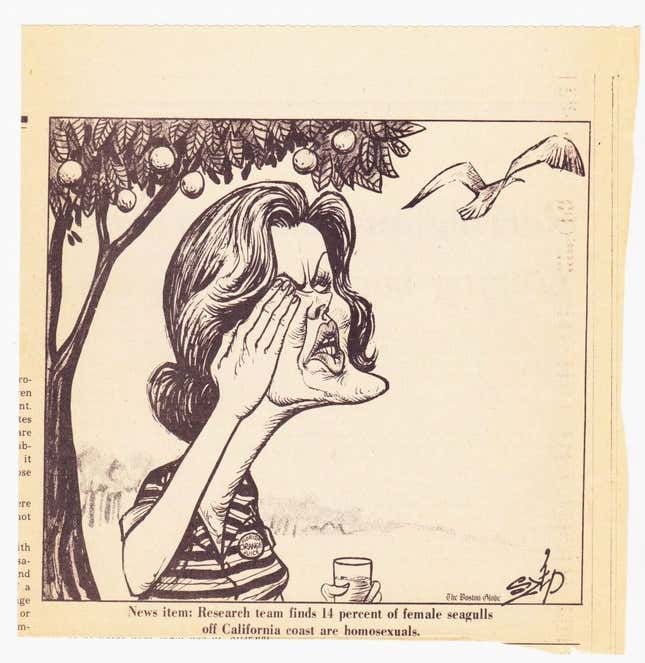
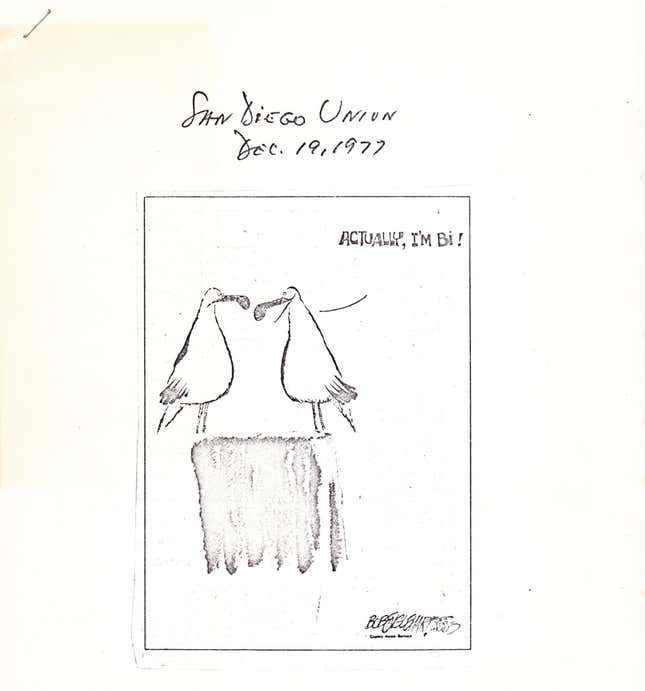
And people from across the country—mostly farmers—sent George letters to tell him about the animals they’d seen who seemed to be gay too:
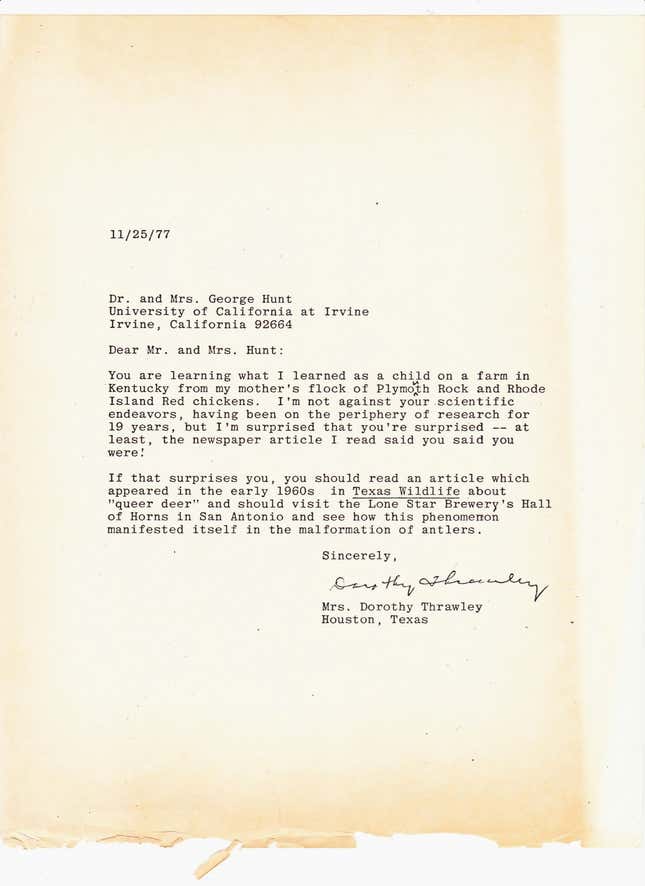
It might go without saying that ornithology doesn’t typically stir such passions. “Most of the time what we do nobody gives a damn about,” George says. But he began receiving letters from LGBT people who were moved by the discovery. “They were very delighted.”
The Hunts found that 14% of the gull pairs on the island were comprised of two females. One telltale sign of a lesbian nest was a “supernormal clutch,” meaning more eggs than a single female could possibly produce.
“They had fertile eggs, which means that females were consorting with males at some point,” George says. But the birds appeared to use the males only for procreation, returning to each other to raise their families.
And once paired, the lesbian couples stuck together. Gulls are known monogamists. “The female-female pairs stayed together from one year to the next. Those that had viable eggs were perfectly able to raise them,” George says.
They seemed perfectly healthy, George says, and their young were too. They were just as capable of raising healthy offspring as their counterparts that grew up with male-female parents.
This was not exactly welcome news in Washington, DC.
After the researchers’ received their first grant from the National Science Foundation, their funding was brought up in a 1978 House of Representatives hearing on a bid to cut the NSF budget. Conservative lawmakers were scandalized. “It held up the NSF [National Science Foundation] funding for 10 days. This obviously touched a very, very raw nerve,” George said.
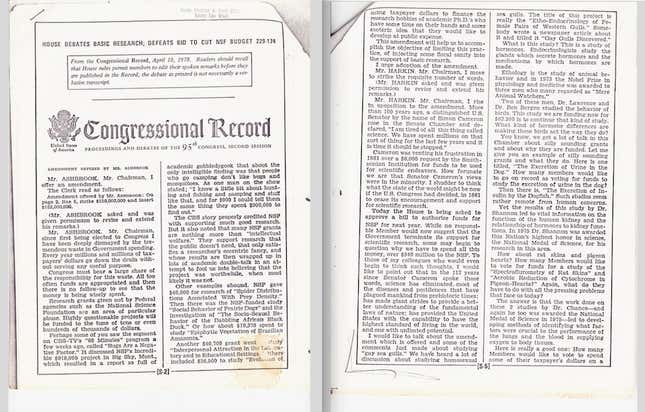
But George continued the research nonetheless, teaming up with new colleagues in 1978 and setting out to find a reason for the gay gulls. (He and Molly had divorced by then; Molly is now a neuropsychologist at Seattle Children’s Hospital.)
First they checked the gulls’ hormones, finding nothing askew: “We got a grant to see if either of the individuals in the female female pairs were more masculine, endocrinologically, than others. And it turns out they weren’t.”
Then, they looked at behavior. But this wasn’t the case of one gull in behavioral drag, either: As George and other colleagues would conclude in a 1984 paper, “We…reject the hypothesis that female-female pairing is the result of either the adoption of a ‘male’ behavioral role by one or both partners, or an extreme ‘female’ role by one member.” Nope, these were two female gulls, being female gulls in every conventional sense—aside from their long-term relationships with one another.
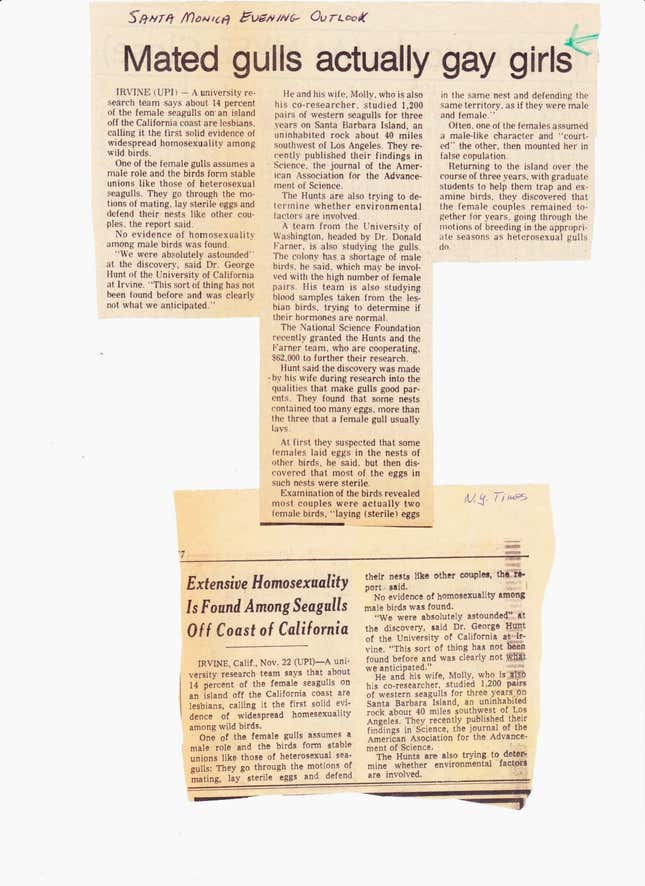
To this day, George is not completely sure of a biological “cause,” and the female-female pairing phenomena disappeared on the island by the 1990s. The best reason he could find was a basic lack of males. “We found there was a heavily skewed sex ratio on the island. We had way more females than males. It was shocking,” he says. “And the lack of males was probably due to high mortality.”
The males, he posits, were dying off because of exposure to DDT, the insecticide that was banned in the US in 1972, but would have taken a number of years to disappear from gulls’ food sources. DDT builds up within fat; female seagulls were likely exposed to the chemical too, but they could hypothetically offload the DDT from their bodies into the fatty yolks of the eggs they laid. Males had no system to rid their bodies of the chemical, and, George posits, would die from a lethal dose when their bodies used up fat stores during cold winters.
Since then, homosexual behavior has been documented in many hundreds of species, though an exact number is hard to come by (the New York Times suggests 450, the University of Oslo put the figure at 1,500), with various animals—albatrosses, for example—exhibiting the same type of apparently non-sexual, long-term, same-sex pairing the Hunts found in the gulls.
But in the late 1970s, gay animals weren’t yet old news, and the lesbian seagulls briefly became a cultural touchstone. In the 1990s, a Los Angeles theater put on a play called “Supernormal Clutches,” and LGBT groups asked George to take them out on gay-gull-finding expeditions. “Unfortunately there were none by that time,” George says, but no one seemed to mind. The participants were always enthusiastic.
“I think it was about being able to see for themselves that they were part of the world. That other organisms could pair up, and there was nothing wrong with it. It was really quite poignant, to see their excitement.”
